Lord Muck's Blog
April 30, 2024
I have visited Kelmscott Manor, the country home of William Morris and family close to the Thames in rural west Oxfordshire, quite a few times over the past 40 odd years. It is always a delight, even on the summer boat trip up from Oxford in 2019 when it poured with rain the entire day. But the trip out for Lord Muck’s seventyth birthday was a particular delight, both for the company and for the time to explore the garden at leisure. In the past I have tended to focus on the house, its history, and Morrisian associations, including the many items in it so closely connected with them, portraits by Rossetti, settle, bed, tapestries and the sense of absorbing just how they lived in that collection of rooms, corridors, attics, nooks and crannies that go make up that most romantic of houses. I didn’t miss any of this on this visit either, but the weather and the season encouraged a more detailed exploration of the garden too. My previous blog a couple of months ago on Morris and plants and their uses both in dyeing and as inspiration for his many designs, aroused my interest in ‘Morris the gardener’. As Fiona MacCarthy put it despite not being a keen gardener himself he had ”…a deep appreciation of a garden’s possibilities”. So a visit to the Manor where there is a glorious setting and plenty of opportunity for practical application, was an opportunity to test this.
There is in fact a book called The gardens of William Morris (Hamilton, Hart & Simmons 1998) with a very fetching painting of Kelmscott Manor set in its garden by the Morris’s friend Marie Stillman on the front cover. It is very good on the principles of the Morrisian garden, if we are to believe such a thing exists, connecting it with the distinctive natural character of a place, the importance of the thread of indigenous flora in Morris’s artistic work, and the idea that Morris’s ideal garden contained the essence of the man and his history; ”From his boyhood reading came chivalric scenes and romantic images of knights and ladies in vine-covered bowers. From studying Gerard’s sixteenth century Herball with its woodblock drawings of plants, he retained the picture of an early garden all cruciform paths and neat raised beds.” The authors are bold enough to set our the principles of Morris’s garden design. They are pretty timeless and make a lot of sense. Basically: unify house and garden; enclose the garden with trees, hedges or natural looking fences; preserve local identity; plant simple flowers; eschew fashion; integrate existing trees; make it productive; and, include places for recreation and relaxation. I’d settle for that in any garden of mine.
So does Kelmscott Manor’s garden measure up? It certainly starts off with a number of significant advantages; beautiful house and out buildings made from old stone, those outbuildings including a dovecote, privvy and various barns allow for walls and hedges to seem like the natural order of things, a significant walled garden, some ancient and impressive trees and the space to allow them to thrive rather than feel constrained or too dominant of a small space, and a certain solitude in the flat, reedy landscape that the house is set in.  The entrance, through a relatively small doorway in the wall leads up to the front door along a flagstone path flanked with standard roses – a view familiar to anyone who has seen a copy of News from Nowhere. That entrance and the layout of the front garden certainly met with Morris’s approval, approaching his ideal, with straight paths and separate ‘rooms’ bounded by old yew hedges. It didn’t take long for Morris to integrate his love of Iceland into the garden, taking his shears to the yew hedge under the gable of the tapestry room and recreating it into a topiary dragon which he named Fafnir after the dragon in The story of Sigurd the Volsung (1876) .
The entrance, through a relatively small doorway in the wall leads up to the front door along a flagstone path flanked with standard roses – a view familiar to anyone who has seen a copy of News from Nowhere. That entrance and the layout of the front garden certainly met with Morris’s approval, approaching his ideal, with straight paths and separate ‘rooms’ bounded by old yew hedges. It didn’t take long for Morris to integrate his love of Iceland into the garden, taking his shears to the yew hedge under the gable of the tapestry room and recreating it into a topiary dragon which he named Fafnir after the dragon in The story of Sigurd the Volsung (1876) . It is still there, breathing fire.
It is still there, breathing fire.
Beyond the formal garden, the area of orchard and meadow leading down to a stream has ash, elm, elder, poplar, and willow along with hawthorn hedging and apple in blossom. Bird life, something Morris cherished and is reflected in his designs – think ‘Strawberry thief’, is in abundance, though the ‘bird apps’ of my companions seemed to be dominated by rooks. Noisy birds! As for the fruit and veg, well the Morris household table was well known for its productive kitchen garden, and in season there were cherries, strawberries, raspberries, gooseberries apples and plums. The modern tea room (in one of the airy stone barns) maintains the tradition, serving ‘apples quinces, mulberries and damsons’ from the garden. It isn’t hard to see where the mulberries come from.  The tree is huge and like many of its species is held together with ropes, props, and ties, to minimise the chances of falling branches killing the visitors.
The tree is huge and like many of its species is held together with ropes, props, and ties, to minimise the chances of falling branches killing the visitors.
April is a little too early – even with the remarkably warm and wet winter we have endured, to see the main flower beds in their full glory, though honesty, cammasia, and the grey of cardoon foliage – grey was actually Morris’s favourite colour – gave a hint of pleasures to come, and the planting indicated considerable thought as did the fading cowslips and may blossom in the more informal spaces which lit up the Spring. 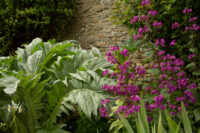 Perhaps the full enjoyment of the garden requires another visit – nothing wrong with seasons. In News from Nowhere the visitors arrive at ‘the old house’ at the end of their up-river journey, in June. As they raised the latch of the door in the wall, ‘My companion gave a sigh of pleased surprise and enjoyment; nor did I wonder, for the garden between the wall and the house was redolent of the June flowers and the roses were rolling over one another with that delicious superabundance of small well-tended gardens which at first sight takes away all thought from the beholder save that of beauty.’ Does Kelmscott today match up to this imaginary space so closely modelled on the 19 century home Morris so cherished? One hundred and fifty odd years afer he first fell in love with it, the answer has to be, yes.
Perhaps the full enjoyment of the garden requires another visit – nothing wrong with seasons. In News from Nowhere the visitors arrive at ‘the old house’ at the end of their up-river journey, in June. As they raised the latch of the door in the wall, ‘My companion gave a sigh of pleased surprise and enjoyment; nor did I wonder, for the garden between the wall and the house was redolent of the June flowers and the roses were rolling over one another with that delicious superabundance of small well-tended gardens which at first sight takes away all thought from the beholder save that of beauty.’ Does Kelmscott today match up to this imaginary space so closely modelled on the 19 century home Morris so cherished? One hundred and fifty odd years afer he first fell in love with it, the answer has to be, yes.
February 21, 2024
Sometimes on wintry days I turn to my gardening books for inspiration and a sense of what might be possible in Spring. But over the past couple of years my attention has been drawn more often to my copy of Gerard’s Herball or Generall Historie of Plantes. Published in 1597 it is the oldest (and thickest) book that I own. Maggie O’Farrell’s superb novel Hamnet has Agnes consulting it on a regular basis. She was a herbalist and she knew about the healing properties of plants. It is rather wonderful to feel that I can get a book off my shelf that she and no doubt William, consulted. I doubt that it is the actual copy, but who knows?
But it is the connection with another William that has particularly intrigued me. Wiliam Morris. As a child he had access to the family copy of the Herball and studied it closely. He also tended a little garden of his own and learned the names and shapes of plants with the Herball’s help poring over its illustrations. It helped him develop his sense of floral colours, textures, scents, structures, and life cycles and although he was never a garden designer, nor even a great ‘practitioner’ of gardening, he had as Fiona MacCarthy puts it in her comprehensive biography of Morris, ‘a deep appreciation of a garden’s possibilities’. Of course William’s early interest in individual flower forms is not so surprising in the person who became the most floral of designers.
But this grounding in both plants and the Herball became far more important later in life as he embraced dyeing in the mid-1870s. He sent Thomas Wardle a copy of the Herball which he said contained ‘useful information about certain disused vegetable dyes’ as he learned about the techniques of dyeing textiles. Before leaving for Leek in Staffordshire where Wardle and his dyeing works were based, he spent two years preparing, mastering the theory while he carried out inital experiments at Queen Square, the family home at the time.  His younger daughter May wrote of this time ‘The air at home was saturated with dyeing: bits of madder and indigo lay about, papers of the kermes insect brought home and its habits and customs explained; dyestuffs of the home country would be inquired.’ Gerards Herball would be read out of an evening to the family, and the two girls, Jenny and May, in their early teens at the time, were given their own sets of dyestuffs. Morris himself was paying extended visits to the Staffordshire works from early 1876, keen to learn the trade. Suzanne Cooper (in How we might live: at home with Jane and William Morris, a delightful new perspective on the Morris’s lives) characterised it as a typically Morrisian activity ”He was keen to get his hands dirty. His eagerness to plunge into the dye vat was almost performative – as if he wanted to prove his worth to the working men who watched him.” Blue to the elbow in smock and clogs. He told Georgie Burne-Jones that he was ‘taking in dyeing at every pore (otherwise by the skin of my hands, which is certain). You know I like that.’ MacCarthy reckons that ‘Blue has a special place in Morris’s colour spectrum. In his poems and his novels it is the sign of happiness, of holidays. Blue was the colour of his working shirts.’
His younger daughter May wrote of this time ‘The air at home was saturated with dyeing: bits of madder and indigo lay about, papers of the kermes insect brought home and its habits and customs explained; dyestuffs of the home country would be inquired.’ Gerards Herball would be read out of an evening to the family, and the two girls, Jenny and May, in their early teens at the time, were given their own sets of dyestuffs. Morris himself was paying extended visits to the Staffordshire works from early 1876, keen to learn the trade. Suzanne Cooper (in How we might live: at home with Jane and William Morris, a delightful new perspective on the Morris’s lives) characterised it as a typically Morrisian activity ”He was keen to get his hands dirty. His eagerness to plunge into the dye vat was almost performative – as if he wanted to prove his worth to the working men who watched him.” Blue to the elbow in smock and clogs. He told Georgie Burne-Jones that he was ‘taking in dyeing at every pore (otherwise by the skin of my hands, which is certain). You know I like that.’ MacCarthy reckons that ‘Blue has a special place in Morris’s colour spectrum. In his poems and his novels it is the sign of happiness, of holidays. Blue was the colour of his working shirts.’
As Cooper remarks it was ‘a time of great inventiveness’.  In April 1876 he registered three new textile designs Tulip, Marigold and Larkspur. At the same time Wardle was making trial prints for Columbine a block-printed cotton in muted green and salmon pink. All four patterns demonstrated the skills that William had learned in designing wallpaper, based on the interplay between flowers and foliage.
In April 1876 he registered three new textile designs Tulip, Marigold and Larkspur. At the same time Wardle was making trial prints for Columbine a block-printed cotton in muted green and salmon pink. All four patterns demonstrated the skills that William had learned in designing wallpaper, based on the interplay between flowers and foliage.  John Gerard’s Herball was hugely popular when it was first published, and an extended and revised edition (rather more botanically accurate than the first) was published in the 1630s. Its influence over the centuries has been significant. And for me it has become something I treasure, for its wisdom, the glory of its illustrations, and for the connections it has with geniuses that I admire.
John Gerard’s Herball was hugely popular when it was first published, and an extended and revised edition (rather more botanically accurate than the first) was published in the 1630s. Its influence over the centuries has been significant. And for me it has become something I treasure, for its wisdom, the glory of its illustrations, and for the connections it has with geniuses that I admire.
June 12, 2023
It is eleven years to to the day since I was issued with my share certiicate for 1,000 ordinary shares in a newly formed co-operative ‘Cultivate’, promoting sustainable farming practices and the production and consumption of locally grown food. Their strap line ‘people-powered food’. What not to like! The prospectus was soooo enticing, a group of people who have come together ‘because we believe in creating positive change to tackle some of the problems facing us both locally and globally including climate change, food security and the loss of culture and skills associated with food producton’. And no shortage of ambition to back it up: ‘In the long term we want Cultivate to become a local food hub working with many other small growers as part of the movement direct supply of susainable healthy local food in Oxfordshire from less than 1% to 10% or more.’ And no shortage of celebrity backers either. Here is Campagn for Real Farming guru Colin Tudge: ‘Britain needs a million new farmers, while three million people are out of work. Could anything be more useful right now, socially and economically than enlightened agricultural projects such as Cultivate?’ The promise was both ambitious and realistic ‘..market research shows…. that there is significant demand for fresh, local food’ ,’..we aim to create new outlets by building up our community support at each of our VegVan sites..’, ‘Restaurant and catering sales will provide a diversified income stream and complement the logistics of the direct retail operation.’ And all that was needed was £55,000 ‘..to get Cultivate running.’
To kick it all off the Cultvate team took on a ten acre patch of farmland on the Earth Trust estate not far from Didcot. Members and there were a few, were encouraged to support the core team by volunteering at the site. Lord Muck mucked in. But visits soon revealed some of the pitfalls in the vision. A large area was devoted to potatoes – hardly a high value crop, and we were encouraged to come and help harvest. But there was a problem. 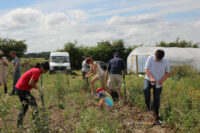 The varierty planted Cara? Arran Pilot? were hightly suseptible to eelworm. It soon became apparent that at least 95% of the crop was irrepairably damaged and completely unsaleable, and sorting out the final 5% wasn’t worth the trouble. If we found a decent spud we could put it in a bag and take it home with us, gratis. Thin pickings. Complete crop failure. This could have been bad luck – farmers the world over have crop failures, or it could have been a mis-reading of the soil type and previous crops. Another potato variety might have thrived. I didn’t know. But more pertinently, nor did the Cultivate team. The first experience of vision coming up against reality. Local production in the hands of people who had never farmed before proved to be more challenging than the business plan/prospectus had anticipated. Many other crops, particularly grown in the poly tunnels did well, customers appreciated them, but could they be produced more cheaply than they could be bought in from local suppliers with decades of experience, and scale to match? Bascially, no.
The varierty planted Cara? Arran Pilot? were hightly suseptible to eelworm. It soon became apparent that at least 95% of the crop was irrepairably damaged and completely unsaleable, and sorting out the final 5% wasn’t worth the trouble. If we found a decent spud we could put it in a bag and take it home with us, gratis. Thin pickings. Complete crop failure. This could have been bad luck – farmers the world over have crop failures, or it could have been a mis-reading of the soil type and previous crops. Another potato variety might have thrived. I didn’t know. But more pertinently, nor did the Cultivate team. The first experience of vision coming up against reality. Local production in the hands of people who had never farmed before proved to be more challenging than the business plan/prospectus had anticipated. Many other crops, particularly grown in the poly tunnels did well, customers appreciated them, but could they be produced more cheaply than they could be bought in from local suppliers with decades of experience, and scale to match? Bascially, no.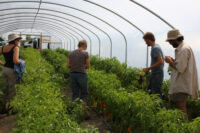
On the other hand the VegVan concept looked like a really interesting innovation. Founder member Joe Hasell, a gardener at Worcester College explained it in an interview in the Oxford Times business magazine: ‘We will establish pop-up markets wherever people want one, outside busines premises or schools for instance.’ The food sold would come from their smallholding or be bought in from other local suppliers. Member investors who were issued with a membership card could claim 10% off food purchasd from the VegVan and the various locations and times were widely advertised. But a significant problem quickly emerged with this too. As time passed reliability at its various stops slipped because the co-op couldnt afford to keep two vans on the road, one collecting the produce from producers and one selling to the public. The collection van had to go, and the sales van had to do doule shifts, and was getting older. When it broke down there was no replacement available to cover. So what was its USP apart from selling local fruit and veg from the back of a van? If you wanted sustainable produce, big companies like Riverford or Abel & Cole were happy to oblige and deliver to the doorstep, and if the local dimension and the associated sociability was a premium, then the farmer’s market network could provide.
If you wanted sustainable produce, big companies like Riverford or Abel & Cole were happy to oblige and deliver to the doorstep, and if the local dimension and the associated sociability was a premium, then the farmer’s market network could provide.
That this was a problem soon became apparent at a pretty stormy AGM in 2013 ie barely a year into operation. North Aston Organics put in a heartfelt appeal that Cultivate quit acting as a competitor and coordinate with their existing box-scheme. Essentially what local suppliers were finding was that Cultivate was buying off them and re-selling to their own customers. But sales were good, or at least good enough with the support of volunteer members (around 400 or so investors in all) and the support of various charitable trusts. But as a business model it didn’t work. While staples like pototoes and carrots could be sold at ‘loss leader’ prices in the hope of attracting cusotomers in and then get them to buy the more premuim produce at prices to match, those prices put people off. Sales of profitable veg sinmply didn’t cover the operating costs. An attempt to enter the veg box scheme didn’t work out either, as the ‘big boys’ had already cornered most of the market and the infrastructure – vans and delivery drivers as well as a cooled distribution centre were expensive. By 2016 the VegVan (yes, just the one) was showing its age, and the co-op had withdrawn from the Earth Trust smallholding recognising that the lovely veg that could be grown there could also be grown more cheaply, by others locally.
The end didn’t come quickly. The 2018 AGM, the last one Lord Muck attended in person, wasn’t quorate, so the facilitated sessions on ‘brand’, ‘membership’, ‘Cultivate online’ etc had a forlorn sense about them. Like with so many other brilliant ideas, the pandemic rang down the final curtain. By late summer 2022 Cutivate had ceased trading, and officially ceased to exist at the end of April.
It is hard to draw lessons. But a few tentative thoughts are:
idealism won out over the nitty-gritty of getting the job done. Especially in the first few years there was huge emphasis on quite abstract goals to do with sustainable farming, food security and climate change; the niche of a VegVan was too small to be viable, and as a result Cultivate ended up competing with some of its supppliers and potentially undercutting farmer’s markets; alternatives such as online retailing were tried before being properly thought through. Riverford, Abel & Cole and even very local but already well established outfits like ‘Veg in Clover’, already had the market covered; over reliance on charitable/grant giving trusts masked the underlying problems in the business model and dragged out the final reckoning; and finally, the impact of the cost of living crisis and all the associated responses to an increasingly difficult macro-economic context, perhaps exemplified in the rise of food banks over the past decade, meant that even the relatively affluent demographic that Cultivate appealed to couldn’t or wouldn’t buy enough produce at the prices they were selling it at. There was a touching, and telling, observation in Cultivate Chair Sarah Flood’s introduction to the 2016 Annual Report, where she characteised the loss that year as ‘We do still need to bump Cultivate over the line to turning a profit, but an extra bag of salad here or an extra bunch of carrots there, and we’re there..’ Was it all lost for nary a bunch of carrots?
February 28, 2023
So tomatoes, cucumbers, peppers and salad crops are all in short supply right now in Britain’s supermarkets. Indeed Tesco, Aldi, Lidl and Morrisons are all rationing customers to a single item or bag of these valuable vegetables. Why? Allegedly because of adverse weather conditions in Spain and Morocco. Some unpatriotic people on seeing supermakets across Europe, including Ukraine, well stocked with all these delicacies as normal, suspect another reason, the impact of Brexit-induced red tape. Others suspect the cost of energy to heat UK greenhouses. But there is a Government-approved solution to the shortages. Turnips. Environment Secretary Therese Coffey used last week’s National Farmers Union conference in Birmingham to extol their virtues, allegedly under the guise of ‘eating local and seasonal’. It hasn’t gone down well in the popular press.
Turnips have an odd cultural resonance. Ever since ‘Turnip’ Townshend aka Second Viscount Townshend (1674-1738), he of Raynham Hall in Norfolk, begain his agricultural experiments in the early 18 Century, the turnip seems to have acquired a special place in our national story. His invention of the four crop rotation method: turnips, barley, clover, and wheat, led to a significant improvement in agrcultural production three hundred years ago. But even he considered the turnip crop suitable only as animal feed. Baldrick in Blackadder was a big turnip fan, especially if they looked like a ‘thingy’ (they don’t) and had much amusement serving up especially carved ones that reminded people of ‘their wedding night’. Which proves that they were popular as long ago as medieval times.
In fact they were popular in medieval times when they were referred to as ‘neeps’ as in haggis, tatties and neeps – the only context in which that term is still in use, and Gerard in his Herbal (1597) refers to ‘small turneeps’ which he considered particularly sweet and tasty, that were grown in the village of Hackney and brought to London for sale in the market at Cheapside. The interesting question is why they fell out of fashion so quickly. Seemingly by the late 17 Century the arrival of new root vegetables such as potatoes and sweet potatoes from the New World displaced them, as well as the rapid increase in sugar production also mainly from the New World, a simpler substitute for the sought after sweetness.
More recently – than the Blackadder series that is, they were a source of abuse, when the England football team lost an international to Sweden in 1999. The Sun’s headine on this humiliating event: ‘Swedes 2 Turnips 1’. But to prove that you can’t keep sex (thank you Baldrick) out of politics, when our ‘blink and you missed her’ Prime Minister Liz Truss was seeking selection in 2010 for a Tory seat in – where else, Norfolk, and was rumbled to be having an affair, or at least sharing their mutual interest in turnips, with a married Tory MP, her local Association tried to get rid of her – a married woman, sex in the 21 Century, whatever next! The press rode to her rescue, labellng them, what else, but the ‘Turnip Taliban’. She may have lasted long enough as PM to crash the economy (£40bn and counting) but her legacy also seems to be to have promoted the hitherto unknown Therese Coffey to Ministerial office (Deputy PM no less) and her skirmish with the ever topical turnip. The Daily Star, having managed to get a lettuce to outlast PM Truss’s tenure, has now started a similar challenge – to see if Coffey can outlast a turnip. As fellow East Anglian grandee ‘Turnip Townsend’ could have told her 300 years ago, that is a risky bet for Coffey. It is no accident they are fed to over wintering livestock – because they last so long!
August 17, 2022
When things get serious the images of drought that the media come up with are generally empty lakes, rivers, or reservoirs, the dried mud of their normally unexposed beds cracked into a crazy-paving of distress. Or if it is really bad, images of the skulls of cattle staring hollow-eyed up at the camera, scattered over a parched and dusty landscape. Usually in Africa or somewhere cinematic like Death Valley. Until this weekend I hadn’t realised that there was an English equivilent to this apocalyptic image right there in front of me. But watering my allotment – watering cans only of course – and staring at the devastation around me as I tried to decide what to save and what to lose, I was struck by the perfectly dried brown leaves of my rhubarb plants lying on the ground, large, dessicated, abandoned to their fate, and with an uncanny resonance at least in my imagination, to those bleached dustbowl cattle skulls. I’d never looked at a rhubarb plant like that before, but as they say, once seen it can’t be unseen.
But sadly, no sound of thundering hooves coming over the dusty horizon, no water company cavalry riding to the rescue. Quite the opposite in fact, as each day trudging down to water, in what felt like an increasingly unproductive ritual, I passed by, no through, a massive water leak from yet another burst mains pipe. Fresh water gushing up between the cracks in the pavement, splitting the tarmac of the road surface and coursing down the street, forming into gigantic puddles in the depressions in the pavement where the cycletrack meets the pedestrian walkway under the glowering sun. Enough water to turn an allotment site not 30 metres away into a lush and verdant paradise of fruit trees, flowers and vegetables. Cattle, and those cavalry horses tethered and grazing peacefully in the shade of the hedge. No, the sun must be getting to me, that would be more of a mirage.
But of course that isn’t what happens. Instead, its official. Most of England is experiencing drought, and the debate seems to be whether it is the worst since 1976, for about one hundred years, or since records began. The TV announcer intones that it has been the driest July since 1885. Meanwhile press reports suggest that in Western Europe the drought is the worst for 500 years as major rivers including the Danube and Rhine dry up, revealing their ‘Hunger stones’ the most famous of which on the Elbe says ‘If you see me, then weep’, rendering these arteries of commerce for centuries, unuseable. And the cure? To ban hose pipes in gardens, allotments, or for the cleaning of cars or windows (unless that is your business of course) from 24 August. Just as the severity of the drought is debated, so too is the percentage of water leaking from those burst mains. Tweny percent? A third? 42%? It depends which company, which year, or how long the timeframe under consideration. For sure the water companies have been promising to tackle leaks, bring down the losses, for the past 20 years. Oddly the percentage of losses from leaks has stubbornly remained the same all that time. But the profits and dividends to shareholders have kept on flowing, gushing even. Corporate PR… rhubarb, rhubarb.
July 19, 2022
It was the one decent afternoon on what was otherwise a very rainy, windy, and stormy mountain walking and trekking trip to Wester Ross and Skye – while the rest of the country was basking in warm sunny summer weather. But a visit to Inverewe Gardens on the shores of Loch Ewe was always going to be a highlight of the trip, and the weather obliged. Inverewe Gardens really are in one of the most unlikely spots imaginable. Less than 100 miles from Cape Wrath on a latitude of 57.8N they are closer to the Arctic Circle than St Petersberg, and on one of the most windswept coastlines in the world. In 1863 when Osgood Mackenzie acquired the promontory along with 12,000 acres of farms, crofts and their tenants, and a huge area of impoverished heathland and bog, it didn’t look like much of a prospect for a sub-tropical garden. But Osgood didnt see it like that. He had done the European ‘Grand Tour’ and witnesed the Italianate terraced garden style. Why not in Wester Ross? He also wanted a baronial mansion ‘built in local stone with typically whimsical turrets and gables in the Highland style’ as it present owners the National Trust for Scotland put it. And woodland and garden to match. 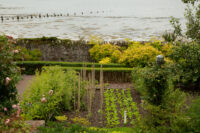 By 1870 he had established a productive walled garden to raise fruit vegetables and flowers, achieved by excavting and terracing a raised beach beside the sea. But the windswept nature of the site meant a woodland shelter-belt for the rest of the site was a must, and he set about planting over 100 acres of woodland, using mainly native Scandinavian Scots pine, but also any other trees he could lay his hands on, including birch, rowan, oak, beech, larch, alder and Corsican and Austrian pine. By 1880 the dogged deternination (and cash) had paid off and by 1883 a visitor wrote to The Times praising both the walled garden and ‘the newly planted hanging woods’. Inverewe became his lifetimes work and by the time of his death in 1922 had become internationally acclaimed, with plants from all over the temperate world, northern and southern hemispheres, taking advantage both of the warming effects of the Gulf Stream on the Wester Ross coastline, and the micro-climate created by that wooldland shelter-belt.
By 1870 he had established a productive walled garden to raise fruit vegetables and flowers, achieved by excavting and terracing a raised beach beside the sea. But the windswept nature of the site meant a woodland shelter-belt for the rest of the site was a must, and he set about planting over 100 acres of woodland, using mainly native Scandinavian Scots pine, but also any other trees he could lay his hands on, including birch, rowan, oak, beech, larch, alder and Corsican and Austrian pine. By 1880 the dogged deternination (and cash) had paid off and by 1883 a visitor wrote to The Times praising both the walled garden and ‘the newly planted hanging woods’. Inverewe became his lifetimes work and by the time of his death in 1922 had become internationally acclaimed, with plants from all over the temperate world, northern and southern hemispheres, taking advantage both of the warming effects of the Gulf Stream on the Wester Ross coastline, and the micro-climate created by that wooldland shelter-belt.
One hundred years later the garden is a joy, visited by thousands of visitors every year. Indeed its five millionth visitor is expected to pass through the entrance gate sometime this year. First impressions are of its setting. On a large sea loch the surrounding area is still pretty wild, even if the neaby village of Poolewe is larger and more commercial than 100 years ago. The loch, the promontory, and the views towards the lofty peaks of Torridon are a spactacular context in which the walled garden, the first element of the estate the visitor encounters, nestles. Neat rows of flowers and vegetables, and cordon apple trees trained along the walls are testament to Osgoods original vision, and located with a southern facing parabolic aspect, in the sunniest part of Inverewe.  Less expected are the artworks carefully inserted into this intimate space; James Parker’s 2014 piece Sheltered existence or the wrought iron doors set into stone arches with paths leading down from the garden to the shoreline a few metres away. Coming up throughh the rockery – again almost on the shoreline and subject to salt spray from frequent winter gales ‘an extremely defiant coastal statement’ as the interpretation board puts it, the ‘big house’ looms – though nothing like the one Osgood had imagined. That was burned to the ground in 1914 and its much less ambitious replacement by his daughter Mairi Sawyer only completed in 1937. Mairi was key to keeping the spirit of Inverewe alive, and after the death of her husband in 1945, kept the garden going alone during the labour shortages of the post War 1940s, before handing it over to the National Trust for Scotland in 1952.
Less expected are the artworks carefully inserted into this intimate space; James Parker’s 2014 piece Sheltered existence or the wrought iron doors set into stone arches with paths leading down from the garden to the shoreline a few metres away. Coming up throughh the rockery – again almost on the shoreline and subject to salt spray from frequent winter gales ‘an extremely defiant coastal statement’ as the interpretation board puts it, the ‘big house’ looms – though nothing like the one Osgood had imagined. That was burned to the ground in 1914 and its much less ambitious replacement by his daughter Mairi Sawyer only completed in 1937. Mairi was key to keeping the spirit of Inverewe alive, and after the death of her husband in 1945, kept the garden going alone during the labour shortages of the post War 1940s, before handing it over to the National Trust for Scotland in 1952.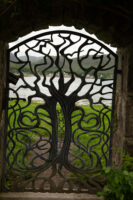
It is easy to get lost in the Big Trees that surrond the house to the north and west, a huge calming space that leads out onto Am Ploc Ard, the High Bluff, and eventually the Devils Elbow and the Cuddy Rock promontory. But nature has intervened. Much of the further parts of the gardens are now inaccessible, thanks to Storm Corrie which tore through the gardens on 29 January this year. Huge trees have been torn up, shattered, their roots pointing skywards, taking with them under-storey and bushes, blocking paths, ponds and watercourses, and turning a spectacular and unique natural enviromnent into something akin to a clear-felled logging site.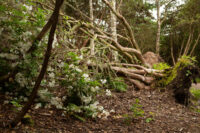 Not all is lost. Only one third of the garden area at most, was badly affected and the loss of trees allows other plants to grow and new life to colonise those newly-exposed root systems. Older trees were more vulnerable and some would have needed to come down for safetly reasons in the next decade anyway. Nature can be brutal in its finality. But of course we all know that such storms are going to become more and more common, and their ferocity on probably already heat or drought-stressed (even in Wester Ross!) habitats, more severe in decades to come.
Not all is lost. Only one third of the garden area at most, was badly affected and the loss of trees allows other plants to grow and new life to colonise those newly-exposed root systems. Older trees were more vulnerable and some would have needed to come down for safetly reasons in the next decade anyway. Nature can be brutal in its finality. But of course we all know that such storms are going to become more and more common, and their ferocity on probably already heat or drought-stressed (even in Wester Ross!) habitats, more severe in decades to come. 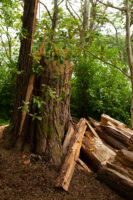 Walking back along the Fictolacteum Walk and up by the Peace Plot (created by Osgood after the horrors of WWW1) in the evening sunight, these reflections on loss and grief make both the vision of Osgood and Mairi, and the tenuous nature of our own existence all the more powerful.
Walking back along the Fictolacteum Walk and up by the Peace Plot (created by Osgood after the horrors of WWW1) in the evening sunight, these reflections on loss and grief make both the vision of Osgood and Mairi, and the tenuous nature of our own existence all the more powerful.
May 7, 2022
Its well over two years since the Covid19 pandemic started. During the first lockdown the allotment was a place of solace and ‘socially distanced’ company, as well as a chance to engage with and listen to nature under that memorable clear blue sky. I escaped Covid. Until I didn’t. Which had of course – sods law, to be around six weeks after its officially declared ‘end’. I had had the three official vaccines, and a further one as part of a trial, whch was considered pretty ineffective, so I was encouraged to take up that third jab in December last. Catching Covid without the vaccines was a nightmare for many, and much worse still for around 175,000 of our fellow citizens (and still counting) but for me in early April it seemed to be no more than an annoyance and a major inconvenience. I had just completed a new potato bed on the allotment, a space that had opened up because my neighbour had removed a couple of large fruit trees whose roots were taking up significant amounts of space and whose branches were shading both my and her plots. So again the allotment became a place of solace.
With no restrictions, officially I could do what I wanted and go where I pleased, but a sense of civic responsibility combined with a level of unwellness that was debilitating if hardly dramatic (thank you vaccines), and that isolated plot at the top of the allotment site well away from anyone else seemed like the ideal place to summon up those reserves of energy to fight the infection and begin to heal in the sunshine and warm breeze. That potato bed was calling. It was Easter time and the tradition of planting on Good Friday still has a residual attraction. Even though the date of Easter varies by about a month from year to year – well it would do if its date is set by the cycles of the moon (very pagan), and potato varieties need to be planted at different times too. First earlies, second earlies, maincrop, anyone? So digging deep in my own fight against Covid I planted Charlotte and Rocket. Fine potaotes both, and as my energy recovers two weeks after I finally tested negative, they too show signs of new vigour, and the raise their heads above the newly dug soil in the Spring sunshine.
August 26, 2021
Many years ago when I first took on an allotment on the Bartlemas site I knew fairly little about the Bartlemas hamlet which it curls around. But I recall being surprised, moved and delighted to find myself watering tomatoes and basil of an evening and hearing glorious music and voices coming from the chapel on the other side of the boundary hedge. 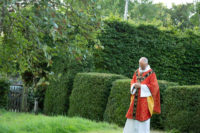 As I learned, the chapel is that of the leper hospital founded in 1126 by Henry I, and uniquely in England, it and its chapel dedicated to St Bartholomew, are still in use, the hospital as a residence.
As I learned, the chapel is that of the leper hospital founded in 1126 by Henry I, and uniquely in England, it and its chapel dedicated to St Bartholomew, are still in use, the hospital as a residence.
The whole site is now a conservation area and a surprising oasis of rurality in the frenetic atmosphere of east Oxford. In fact the chapel, which was used to stable horses when Cromwellian forces were beseiging Oxford in the Civil War in the 1640s and only returned to ecclesiastical use in the early 20 century, is relatively rarely used. But a highlight of its calendar is of course St Bartholomew’s Day, 24 August. St Bartholomew is the patron saint of healing, particularly skin diseases, having allegedly been flayed alive for his beliefs. It is a natural connection to make for a leper hospital, and the holy well in the grounds some 15 metres from the chapel is a reminder of the sacredness of the place for pilgrims, seekers and itinerant holy men (as they would have been in those days).
St Bartholomew’s legacy has been a complex one. In medieval times St Bartholomew’s Day marked the end of summer and the start of autumn. Dew that fell on that day was believed to have healing properties, and pilgrims would come to church in bare feet to have holy dew cure foot ailments. Indeed those with more serious skin diseases would roll naked in the dew for its healing properties. But the turn of the year meant more. The lazy days of summer were passing, and the hard work of bringing in the harvest was about to commence. So it was last chance for revelry and a bit debauchery before the work began and the nights drew in. St Bartholomew’s Fairs, known as ‘Bartlefairs’ or ‘Bartlefeasts’, were common; perhaps the most famous being that held at Smithfield in London from 1133 to 1855. Starting out as a trading event and specifically a cloth fair, it rapidly morphed into something far more louche. By the middle of the 17 century St Bartholomew’s Fair, by now of a size to be of international importance, was far from being somewhere to seek healing or a successful business deal, though quack medicine sellers were common enough. Rather it was an opportunity to experience the exotic; prize fighters, musicians, astrologers, acrobats, contortionists, tightrope walkers, puppeteers, fire-eaters, freak shows, stalls selling everything from ginger bread to singing birds, and wild animals, were part and parcel of the show. Not just any wild animals either. Dancing bears, performing monkeys, caged tigers, baby crocodiles being hatched from eggs by steam, and even a ‘learned pig’ observed by Wordsworth in 1815, were all part of the fun. As were ‘soiled doves’ – not caged birds, but prostitutes in coyly labelled tents, or just ‘off-fair’ in Cock Lane.
It was a source of inspiration for many a literary figure inspiring Ben Johnson’s play Bartholomew Fair, Daniel Defoe whose heroine in Moll Flanders meets a well-dressed gentelman at the fair, and both Samuel Pepys and John Evelyn, who provide vivid descriptions in their diaries. Not to mention Wordsworth and that pig – which could apparently tell the time to the minute and pick out any specified card in a pack while blindfolded. The vulgarity, loutishness and drunkenness of it was all too much for the Victorians and it was suppressed in 1855.  But back at Bartlemas Chapel this 24 August, the glorious service which I had first heard while tending my vegetables, concluded with a glass of pimms on the lawn, a fitting combination of joys of the fairs and the traditions of the healing properties of the great saints memory.
But back at Bartlemas Chapel this 24 August, the glorious service which I had first heard while tending my vegetables, concluded with a glass of pimms on the lawn, a fitting combination of joys of the fairs and the traditions of the healing properties of the great saints memory.
July 19, 2021
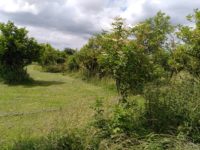 Lord and Lady Muck enjoyed a rather wet camping trip in the Cotswolds near Stroud earlier in the month. The exact location, Thistledown, on the edge of Woodchester Park, is a charming campsite but also an unusual one. The campsite we were informed is on a site where the only Bronze Age storage pit in southern England has been found, along with several Bronze Age roundhouses. It is also the site of a ‘farm, [that] used to contain the largest elderflower orchard in the world!’ and that those ‘.. flowers were used to make soft drinks’. The remains of this orchard still exist, and are a location for those campers who either don’t want to stray too far from their cars, or are staying in camper vans. The rest of us have a longer walk down a steep path to the other pitches, which of course are more secluded and car-free. Now Lord and Lady Muck are no slouches at making elderflower wine or cordial, or indeed elderberry wine, but these are harvested from hedgerow trees or trees (bushes?) on our allotments. Production at scale is clearly still undertaken, hence the various commercial elderflower cordials and presse’s, and the re-purposed orchard prompted reflection on the origins of the commercial aspects of elder production.
Lord and Lady Muck enjoyed a rather wet camping trip in the Cotswolds near Stroud earlier in the month. The exact location, Thistledown, on the edge of Woodchester Park, is a charming campsite but also an unusual one. The campsite we were informed is on a site where the only Bronze Age storage pit in southern England has been found, along with several Bronze Age roundhouses. It is also the site of a ‘farm, [that] used to contain the largest elderflower orchard in the world!’ and that those ‘.. flowers were used to make soft drinks’. The remains of this orchard still exist, and are a location for those campers who either don’t want to stray too far from their cars, or are staying in camper vans. The rest of us have a longer walk down a steep path to the other pitches, which of course are more secluded and car-free. Now Lord and Lady Muck are no slouches at making elderflower wine or cordial, or indeed elderberry wine, but these are harvested from hedgerow trees or trees (bushes?) on our allotments. Production at scale is clearly still undertaken, hence the various commercial elderflower cordials and presse’s, and the re-purposed orchard prompted reflection on the origins of the commercial aspects of elder production.
In fact the Elder (Sambucus nigra) is a mysterious and magical tree native to the British Isles and the name is derived from the Anglo Saxon ‘aeld’ which means ‘fire’, perhaps because the branches hollowed out of their pith were used like bellows for blowing on fire. Elder has long been sacred to an ancient godess of vegetation and is believed to be inhabited by a tree dryad which represents the soul of the tree.  This explains why Elder were often planted close to houses and farms, in the belief that if treated well and honoured, the dryad would protect the house and its occupants against evil spirits. So it is unsurprising that there was a widespread taboo against cutting down or burning its wood, and by the 17C almost every part of the tree was considered medicinaly effective in treating ailments ranging from toothache to the plague. Muck’s 1597 edition of Gerard’s Herbal lists numerous uses and remedies for multiple ailments. So, (I’m updating the English here) ‘The green leaves pounded with deers suet or bulls tallow are good to be laid to hot swellings and tumours, and do assuage the pain of gout.’ Slightly more alarmingly ‘The inner and green bark doth more forcibly purge; it draweth forth choler and watery humours for which cause it is good for those who have the dropsy..’ or more promisingly (though the curative properties must be in doubt) ‘…the fresh flowers are mixed with some kind of meat and fried with eggs; they likewise trouble the belly and move the stool.’ However it was not for another 150 years with the publication of Hannah Glasse’s The art of cookery made plain and simple in 1747, that we find the first recipe for elderflower wine.
This explains why Elder were often planted close to houses and farms, in the belief that if treated well and honoured, the dryad would protect the house and its occupants against evil spirits. So it is unsurprising that there was a widespread taboo against cutting down or burning its wood, and by the 17C almost every part of the tree was considered medicinaly effective in treating ailments ranging from toothache to the plague. Muck’s 1597 edition of Gerard’s Herbal lists numerous uses and remedies for multiple ailments. So, (I’m updating the English here) ‘The green leaves pounded with deers suet or bulls tallow are good to be laid to hot swellings and tumours, and do assuage the pain of gout.’ Slightly more alarmingly ‘The inner and green bark doth more forcibly purge; it draweth forth choler and watery humours for which cause it is good for those who have the dropsy..’ or more promisingly (though the curative properties must be in doubt) ‘…the fresh flowers are mixed with some kind of meat and fried with eggs; they likewise trouble the belly and move the stool.’ However it was not for another 150 years with the publication of Hannah Glasse’s The art of cookery made plain and simple in 1747, that we find the first recipe for elderflower wine.
The use of elder flower to make a cordial seems more recent still. Mrs Beeton in her encyclopaedic Household Management, first published in 1861, makes no reference (though she does provide a recipe for elderberry wine) and the idea seems only to have been taken up commercially after WW2. So the Thistledown Farm enterprise which was written up almost 30 years ago in 1993 by Duff Hart-Davis in The Independent, was something of a trailblazer. The tradition is still carried on at Belvoir Farm in Leicestershire, but all that remains at Thistledown now is the glorious scent when the flowers are in bloom in May and June, and a perfect spot to pitch a tent, even when wet.
March 9, 2021
I knew my correspondence with Prince Charles about chickens would assume national significance one day. That day arrived yesterday when *that interview* between Oprah Winfrey and Harry and Megan was aired on TV around the world. It was about 15 minutes in, that the matter of rescue chickens emerged. There were Oprah and Megan surrounded by the Sussexes rescue hens with Oprah clutching a box of eggs, and Megan with an artfully staged basket full. They looked good for rescue hens, a hybrid variety of uncertain name but certain egg productivity – for a year. But next time maybe they should go for Sussexes – they are such a lovely breed and great for beginners. Anyway, they love chickens, their wee son loves chickens, their hen house is even named ‘Archie’s Chick Inn’ (that American love of puns again that I mentiond in my last blog, not just that ‘Chick Inn’, but the revelation that Megan’s first job as a teenager was in the ‘Humphrey Yougart’ milk bar – adorable). And so does Prince Charles. Perhaps there is an opening here. Harry said in that interview that relations between him and his dad weren’t so good, and indeed Chaz wouldn’t take his calls. A sorry situation. Even an old republican like me can empathise about the family hurt. Which is where that chicken correspondence comes in.
Back in 2008, long before Lord Muck was even a twinkle in his creators eye, the muck narrative was rolling. Warwickshire-based Garden Organic and my employer Warwickshire county council (where I was amongst other things, responsible for waste management) were engaged in discussions about waste minimisation, in particular composting, and the practicalities of encouraging 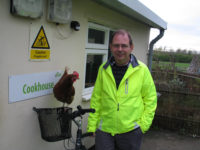 houesholders to keep chickens to reduce food waste. Prince Charles is Garden Organic’s Patron and the idea was ‘hatched’ that we would get his backing for the extension of the then already running Master Composting programme to include a hen keeping module.
houesholders to keep chickens to reduce food waste. Prince Charles is Garden Organic’s Patron and the idea was ‘hatched’ that we would get his backing for the extension of the then already running Master Composting programme to include a hen keeping module.
So I wrote to Clarence House setting out some ideas. A copy of the hand-written notes on this made their way back to me, and remain one of my most treasured possessions. In response to the various suggestions that I put to the Palace, the Prince annotated my letter with comments like ‘Excellent’ and ‘Hooray!’ and signed off to his staff ‘This is encouraging news! Please keep a close eye on this as it develops because, if it works I would like to push the whole concept to other councils…’ It ‘took flight’ as Garden Organic’s ‘Hens@Home’ programme, delivered to Master Composters across the country. Clearly a love of hens is a shared interest between father and son, and here are Megan and Harry happy to share their love with Oprah and 2 billion viewers across the planet.
Living in California I’m sure the Sussexes are into spiritual growth. I’m not so sure if they have got round to reading Clea Danaan’s lovely ‘Zen and the art of raising chickens’ – the sound of one wing flapping, so to speak. But Charles dabbles in Buddhism (allegedly). I suspect that he is more of the ‘chop wood, feed chickens’ kinda guy when it comes to Zen Buddhism. There are many paths up the mountain, but surely ‘The way of the Hen’ is the one that will bring forth familial reconciliation.
 The entrance, through a relatively small doorway in the wall leads up to the front door along a flagstone path flanked with standard roses – a view familiar to anyone who has seen a copy of News from Nowhere. That entrance and the layout of the front garden certainly met with Morris’s approval, approaching his ideal, with straight paths and separate ‘rooms’ bounded by old yew hedges. It didn’t take long for Morris to integrate his love of Iceland into the garden, taking his shears to the yew hedge under the gable of the tapestry room and recreating it into a topiary dragon which he named Fafnir after the dragon in The story of Sigurd the Volsung (1876) .
The entrance, through a relatively small doorway in the wall leads up to the front door along a flagstone path flanked with standard roses – a view familiar to anyone who has seen a copy of News from Nowhere. That entrance and the layout of the front garden certainly met with Morris’s approval, approaching his ideal, with straight paths and separate ‘rooms’ bounded by old yew hedges. It didn’t take long for Morris to integrate his love of Iceland into the garden, taking his shears to the yew hedge under the gable of the tapestry room and recreating it into a topiary dragon which he named Fafnir after the dragon in The story of Sigurd the Volsung (1876) . It is still there, breathing fire.
It is still there, breathing fire. The tree is huge and like many of its species is held together with ropes, props, and ties, to minimise the chances of falling branches killing the visitors.
The tree is huge and like many of its species is held together with ropes, props, and ties, to minimise the chances of falling branches killing the visitors. Perhaps the full enjoyment of the garden requires another visit – nothing wrong with seasons. In News from Nowhere the visitors arrive at ‘the old house’ at the end of their up-river journey, in June. As they raised the latch of the door in the wall, ‘My companion gave a sigh of pleased surprise and enjoyment; nor did I wonder, for the garden between the wall and the house was redolent of the June flowers and the roses were rolling over one another with that delicious superabundance of small well-tended gardens which at first sight takes away all thought from the beholder save that of beauty.’ Does Kelmscott today match up to this imaginary space so closely modelled on the 19 century home Morris so cherished? One hundred and fifty odd years afer he first fell in love with it, the answer has to be, yes.
Perhaps the full enjoyment of the garden requires another visit – nothing wrong with seasons. In News from Nowhere the visitors arrive at ‘the old house’ at the end of their up-river journey, in June. As they raised the latch of the door in the wall, ‘My companion gave a sigh of pleased surprise and enjoyment; nor did I wonder, for the garden between the wall and the house was redolent of the June flowers and the roses were rolling over one another with that delicious superabundance of small well-tended gardens which at first sight takes away all thought from the beholder save that of beauty.’ Does Kelmscott today match up to this imaginary space so closely modelled on the 19 century home Morris so cherished? One hundred and fifty odd years afer he first fell in love with it, the answer has to be, yes.


















